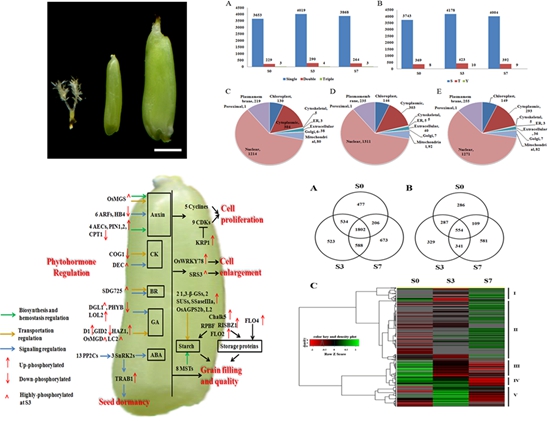分享到
Progress Achieved in Phosphoproteomic Analysis in Rice
PTM (Post-translational modification) is a key mechanism regulating the biological function of proteins. Among the over 300 types of reported PTMs, phosphorylation is the most abundant and well studied one. It is estimated that over 1/3 of the translated proteins are potential phosphoproteins whose function may involve in plant growth, development, biotic and abiotic stress responses. Although a lot of efforts have been done in Arabidopsis, the protein phosphorylation study in rice is much lagged behind. So far, only 3000-4000 phosphoproteins have been identified in rice with most of which are functionally unknown.
Recently, rice reproductive biology team led by Dr. Jian Zhang on China National Rice Research Institute (CNRRI) of Chinese Academy of Agricultural Sciences (CAAS) reported the largest scale identification of the sites, intensities and dynamics of phosphoproteins from rice developing seeds by employing a MOAC phosphopeptide enrichment method associated with LC-MS/MS identification. In total, 2529, 2706 and 2709 phosphoproteins from rice pistils, seeds at 3 DAP (Day After Pollination) and 7 DAP were discovered respectively, including 2487 phosphoproteins showed a DP (differentially phosphorylated) pattern. Some of the DP proteins are master regulators of various biological processes such as phytohormone biosynthesis and signaling, cell proliferation and enlargement, grain filling and quality control, indicating protein phosphorylation/dephosphorylation is a key switch turning on/off protein functions. The research provided one of the largest dataset of rice protein phosphorylation, but also shed novel lights into the molecular mechanisms regulating rice seed development.

Recently, rice reproductive biology team led by Dr. Jian Zhang on China National Rice Research Institute (CNRRI) of Chinese Academy of Agricultural Sciences (CAAS) reported the largest scale identification of the sites, intensities and dynamics of phosphoproteins from rice developing seeds by employing a MOAC phosphopeptide enrichment method associated with LC-MS/MS identification. In total, 2529, 2706 and 2709 phosphoproteins from rice pistils, seeds at 3 DAP (Day After Pollination) and 7 DAP were discovered respectively, including 2487 phosphoproteins showed a DP (differentially phosphorylated) pattern. Some of the DP proteins are master regulators of various biological processes such as phytohormone biosynthesis and signaling, cell proliferation and enlargement, grain filling and quality control, indicating protein phosphorylation/dephosphorylation is a key switch turning on/off protein functions. The research provided one of the largest dataset of rice protein phosphorylation, but also shed novel lights into the molecular mechanisms regulating rice seed development.

This paper has been published online by Plant Molecular Biology on Nov 28th, 2015. ASTIP and Elite Youth Project, CAAS were acknowledged for funding supports. Further functional characterization of the phosphoproteins is undergoing.
Click the link for full text of the articles:
http://link.springer.com/article/10.1007/s11103-015-0410-2/fulltext.html
Click the link for full text of the articles:
http://link.springer.com/article/10.1007/s11103-015-0410-2/fulltext.html
Latest News
-
 Apr 18, 2024Opening Ceremony of the Training Workshop on Wheat Head Scab Resistance Breeding and Pest Control in Africa Held in CAAS
Apr 18, 2024Opening Ceremony of the Training Workshop on Wheat Head Scab Resistance Breeding and Pest Control in Africa Held in CAAS -
 Apr 03, 2024IPPCAAS Co-organized the Training Workshop on Management and Application of Biopesticides in Nepal
Apr 03, 2024IPPCAAS Co-organized the Training Workshop on Management and Application of Biopesticides in Nepal -
 Mar 28, 2024Delegation from the School of Agriculture and Food Science of University College Dublin, Ireland Visit to IAS, CAAS
Mar 28, 2024Delegation from the School of Agriculture and Food Science of University College Dublin, Ireland Visit to IAS, CAAS -
 Mar 25, 2024Director of World Food Prize Foundation visited GSCAAS
Mar 25, 2024Director of World Food Prize Foundation visited GSCAAS -
 Mar 20, 2024Institute of Crop Sciences (ICS) and Syngenta Group Global Seeds Advance Collaborative Research in the Seed Industry
Mar 20, 2024Institute of Crop Sciences (ICS) and Syngenta Group Global Seeds Advance Collaborative Research in the Seed Industry
